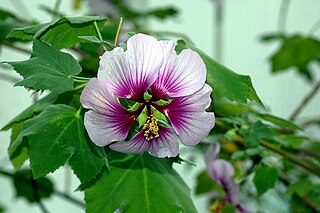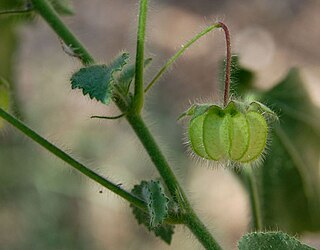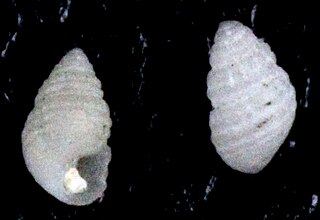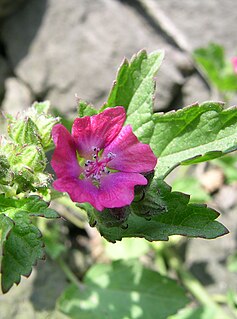
Hibiscus is a genus of flowering plants in the mallow family, Malvaceae. The genus is quite large, comprising several hundred species that are native to warm temperate, subtropical and tropical regions throughout the world. Member species are renowned for their large, showy flowers and those species are commonly known simply as "hibiscus", or less widely known as rose mallow. Other names include hardy hibiscus, rose of sharon, and tropical hibiscus.

Abutilon is a large genus of flowering plants in the mallow family, Malvaceae. It is distributed throughout the tropics and subtropics of the Americas, Africa, Asia, and Australia. General common names include Indian mallow and velvetleaf; ornamental varieties may be known as room maple, parlor maple, or flowering maple. The genus name is an 18th-century New Latin word that came from the Arabic ’abū-ṭīlūn, the name given by Avicenna to this or a similar genus.

Lavatera is a genus of about 25 species of flowering plants in the mallow family Malvaceae, native to Macaronesia, North Africa, Europe, central and southwestern Asia, Ethiopia, North America and Australia, with a centre of distribution in the Mediterranean region. A number of species are naturalized in North America and elsewhere.

Pavonia is a genus of flowering plants in the mallow family, Malvaceae. The generic name honours Spanish botanist José Antonio Pavón Jiménez (1754–1844), as chosen by his contemporary, Spanish botanist Antonio José Cavanilles. Several species are known as swampmallows.
The Botanical and Zoological Codes of nomenclature treat the concept of synonymy differently. In botanical nomenclature, a synonym is a scientific name that applies to a taxon that (now) goes by a different scientific name. For example, Linnaeus was the first to give a scientific name to the Norway spruce, which he called Pinus abies. This name is no longer in use: it is now a synonym of the current scientific name, Picea abies. In zoology, moving a species from one genus to another results in a different binomen, but the name is considered an alternative combination, rather than a synonym. The concept of synonymy in zoology is reserved for two names at the same rank that refer to a taxon at that rank - for example, the name Papilio prorsaLinnaeus, 1758 is a junior synonym of Papilio levanaLinnaeus, 1758, being names for different seasonal forms of the species now referred to as Araschnia levana(Linnaeus, 1758), the map butterfly. However, Araschnia levana is not a synonym of Papilio levana in the taxonomic sense employed by the Zoological code.

Xenophora, commonly called carrier shells, is a genus of medium-sized to large sea snails, marine gastropod mollusks in the family Xenophoridae, the carrier snails or carrier shells. The genus Xenophora is the type genus of the family Xenophoridae.

Wissadula is a genus of flowering plants in the mallow family, Malvaceae. It contains 25 to 30 species of herbs and subshrubs that are mostly native to the Neotropics, with several in tropical Asia and Africa. The name is derived from the Sinhala language.

Iliamna is a small genus of flowering plants in the mallow family, endemic to North America. It is related to the bush mallows of California (Malacothamnus) and to Phymosia of Mexico, Central America and the Caribbean. These perennial herbs are known commonly as wild hollyhocks and sometimes as globe mallows, Kankakee mallow, Kankakee globe mallow, and Streambank wild hollyhock. More often, the latter terms refer to members of the genus Sphaeralcea, which belong, like Iliamna, to the "typical" mallow tribe (Malveae) of the mallow and hibiscus subfamily Malvoideae. The name of the genus, proposed by Edward Lee Greene, appears to be a reference to Iliamna Lake in Alaska, even though the genus Iliamna does not occur in Alaska

Herissantia crispa is a species of flowering plant in the mallow family known by the common names bladdermallow and curly abutilon. It is native to the tropical Americas but it can be found throughout the tropical and warmer temperate world as an introduced species and sometimes a weed. This is a perennial or sometimes annual herb growing up to about 1.5 meters in maximum stem length, usually taking a trailing or creeping form. It is coated in whitish hairs. The oval or heart-shaped leaves are up to 7 centimeters long with rippled edges. The inflorescence is a solitary flower emerging from a leaf axil, borne on a long-haired pedicel which is half erect and then jointed downward. The flower has five pale yellow oval petals each up to a centimeter long. The fruit is a lantern-like inflated sphere ribbed into segments. It is up to 2 centimeters wide, coated in long hairs, and dehiscent, each segment containing 2 or 3 black kidney-shaped seeds.

Talipariti is a genus of plants in the mallow family Malvaceae. It consists of 22 species, which are exclusively tropical except for one species whose range extends into temperate areas of Japan and Korea. Some authors treat these species as part of the genus Hibiscus, in which case they form the section Hibiscus sect. Azanza.

Hibisceae is a tribe of flowering plants in the mallow family Malvaceae, subfamily Malvoideae.
Radyera is a genus of flowering plants in the family Malvaceae.

Turris is a genus of sea snails, marine gastropod mollusks in the family Turridae, the turrids.

Miralda is a genus of sea snails, marine gastropod mollusks in the family Pyramidellidae, the pyrams, and their allies.

Sida hermaphrodita, known by the common names Virginia fanpetals and Virginia mallow, is a perennial forb native to the eastern United States, which produces white flowers in summer.

Perilla is a genus consisting of one major Asiatic crop species Perilla frutescens and a few wild species in nature belonging to the mint family, Lamiaceae. The genus encompasses several distinct varieties of Asian herb, seed, and vegetable crop, including P. frutescens (deulkkae) and P. frutescens var. crispa (shiso). The genus name Perilla is also a frequently employed common name ("perilla"), applicable to all varieties. Perilla varieties are cross-fertile and intra-specific hybridization occurs naturally. Some varieties are considered invasive.

Fuertesimalva is a genus of flowering plants in the mallow family Malvaceae, native to Mexico, Venezuela, Columbia, Ecuador, Bolivia, Peru and Argentina. Most species in this genus were originally placed in Urocarpidium.
Krapovickasia is a genus of flowering plants in the mallow family Malvaceae, disjunctly distributed in Mexico, Brazil, Paraguay, Uruguay and Argentina. Perennial herbs, they have yellowish to peach or faded rose colored flowers.
Bastardiastrum is a genus of flowering plants in the mallow family Malvaceae and is native to Mexico. They are shrubs or subshrubs with viscid stems.















